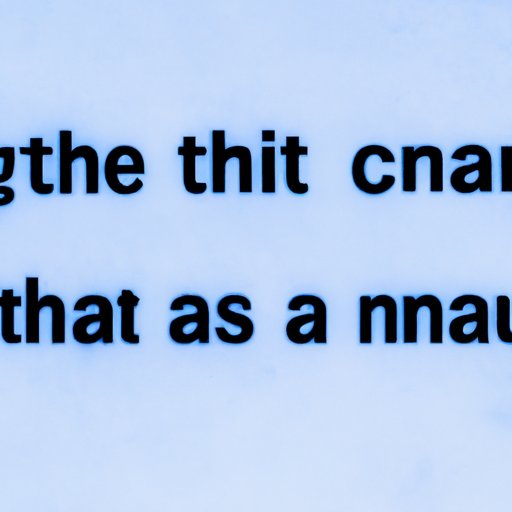Introduction
Have you ever found yourself unsure whether to use “that” or “which” in your writing? You’re not alone. The battle of “that vs which” has been a common problem for writers of all levels for decades. These two words may seem interchangeable, but they are actually used in different ways, and using the wrong one can change the meaning of your sentence. In this article, we will explore the differences between “that” and “which”, provide tips for avoiding common errors, explain how tone and context matter, simplify the grammar rules, and clarify the impact of punctuation.
Exploring the Differences
Before we dive into the differences between “that” and “which”, let’s briefly define the two terms. “That” and “which” are both used as relative pronouns, which means they connect a clause to a noun. However, “that” is used to introduce an essential clause, while “which” is used to introduce a non-essential clause.
Essential clauses are those that are necessary to the meaning of the sentence, while non-essential clauses provide additional, non-essential information. For example:
“The computer that I bought last week is already broken.”
“My new computer, which I bought last week, is already broken.”
The first sentence uses “that” to introduce an essential clause – the type of computer is important to the meaning of the sentence. The second sentence uses “which” to introduce a non-essential clause – the fact that the computer is new is not essential to the meaning of the sentence.
It’s important to note that even though “that” introduces essential clauses, it can also be used to introduce non-essential clauses in informal speech or writing. However, using “which” to introduce an essential clause is considered incorrect in formal writing.
Common Errors to Avoid
One of the most common errors people make when using “that” and “which” is using “which” instead of “that” to introduce an essential clause. This can lead to confusion or ambiguity in meaning. For example:
“The car, which has a broken window, is in the garage.”
“The car that has a broken window is in the garage.”
In the first sentence, it’s unclear which car is being referred to as all cars in the garage may have a broken window. In the second sentence, it’s clear that only the car with a broken window is in the garage.
To avoid this common error, always use “that” for essential clauses and “which” for non-essential clauses.
Tone and Context Matters
While the grammar rules for “that” and “which” are important to follow, it’s also essential to consider tone and context when choosing between the two words. For example, using “which” to introduce a non-essential clause could lend a more casual or conversational tone to your writing, while using “that” for essential clauses could help convey a more formal or serious tone.
Additionally, context also plays a significant role in determining which word to use. For example:
“My favorite book, which is a mystery, has a surprise ending.”
“My favorite book that I just finished has a surprise ending.”
In the first sentence, “which” is used to introduce a non-essential clause providing additional information about the book. In the second sentence, “that” is used to introduce the essential clause specifying which book is being referred to.
It’s important to remember that ultimately, clarity and precision should always be a priority, even if it means sacrificing tone or style.
Simplifying Grammar Rules
While it may seem daunting to remember all the different rules for “that” and “which”, there are a few simple guidelines to follow that can help keep things clear:
- Use “that” for essential clauses.
- Use “which” for non-essential clauses.
- Use commas with “which” but not with “that.”
For example:
“The cake that I baked yesterday was delicious.”
“The cake, which I baked yesterday, was delicious.”
The lack of a comma in the first sentence is an indicator that “that” is being used as an essential clause. The presence of a comma in the second sentence indicates that “which” is being used as a non-essential clause.
Understanding the Punctuation
As we briefly mentioned in the previous section, punctuation plays a crucial role in the correct usage of “that” and “which.” In general, a comma should be used with “which” to indicate that the clause is non-essential. No comma should be used with “that” to indicate that the clause is essential.
For example:
“The shoes, which are in the closet, don’t fit me.”
“The shoes that I bought yesterday don’t fit me.”
The use of a comma in the first sentence indicates that the clause is non-essential, whereas the lack of a comma in the second sentence indicates that the clause is essential to the meaning of the sentence.
Conclusion
Understanding the differences between “that” and “which” can be difficult, but with practice and attention to detail, you can master this essential part of grammar. Remember to use “that” for essential clauses and “which” for non-essential clauses, and use commas to indicate non-essential clauses. Always think about the tone and context of your writing, and above all, strive for clarity and precision.
For further practice, consider using an online grammar tool, such as Grammarly, or consult a writing handbook such as The Chicago Manual of Style.
